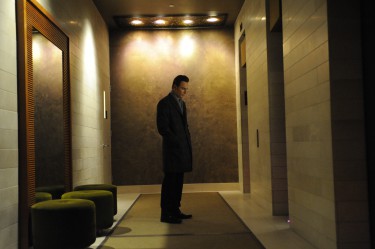 Back to selection
Back to selection
COCK OF THE WALK: THE NEW YORK FILM FESTIVAL (PART THREE)
Three films, three male protagonists, all of whom fall for extended periods of time from their elevated perches. In this, the final installment of my coverage of the 49th edition of the New York Film Festival, we see how their descents are manifest in the newest works of three proven talents — okay, all of them men: British director Steve McQueen, the American Alexander Payne, and Frenchman Michel Hazanavicius.
In Shame, messy sister Sissy (a wonderful Carey Mulligan) takes on that function. An aspiring singer, she arrives unexpectedly — and unwanted‚ at Brandon’s expensive but austere high-rise apartment (he is a neat freak, and there is nothing on the walls). We notice something disturbing when they first see each other: they are both fully naked. (Brandon is totally undressed even in the first scene, and in fact is frequently without clothes, as was Fassbender in Hunger; one of McQueen’s shorts featured two nude men. I think he finds the male torso of tremendous aesthetic interest.)
The siblings exchange roles. He is unable to maintain his sexual habits with her crashing on his couch, yet she, whose sexual history we do not know, is at ease picking up her brother’s boss and best friend, Dave (James Badge Dale), and taking him to the apartment for a highly audible tumble. For the first time, Brandon loses his cool, moving about frantically, then rushing out for a middle-of-the-night jog.
He comes close to breaking through to a communicative relationship with a lovely office colleague, but when they finally start to consummate, he is unable to perform. Something besides his worldview through a sexual filter has caught up with him, and that something is Sissy. “We’re not bad people, we just come from a bad place,” she says at one point. Clearly something incestuous in their pasts he has bottled up so tightly has determined his priorities of thought and actions during his young life.
McQueen has worked in several media, and the eyes of an artist are here in spades, more than in the fine Hunger (another collaboration with Fassbender), his first feature. Shame may be mostly a two-hander, but abstractions of color, as if through a prism, add density to scenes in his apartment, for example. The views are not of conventionally blue skies and sleek and new or old and charming skyscrapers but of grayness and isolated industrial structures that bear the signature of an artist creating his own reality (one that mirrors the void inside his protagonist’s mind). Yet he is on top of things as a film director, the mise-en-scene and editing rhythms just right for the story.
Fassbender’s few breakdown eruptions perfectly balance the more frequent seductive close-ups of his toothy smile. What distinguishes him from his contemporaries, though, is his uncanny ability to convey a ton of information with just a look. When Dave makes a fool of himself trying to pick up a girl in a bar, Brandon stares at the two with an intense iciness that reveals what he is thinking: He would easily betray his closest (and possibly only) friend (and he will), and he could (and does) easily score with the young woman. After his failure at creating some sort of rapport with a warm office mate, he gazes into the camera while engaged in coitus with a woman he has just met, his frenzied eyes revealing how shaken his equilibrium and relationship to his own sexuality have become.

Payne is a very good, disciplined, and unobtrusive director, and his intuitive feel for timing results in an effective blend of pathos and comedy. The Descendants, his first feature since the 2004 Sideways, retains some of Payne’s signature devices, such as voiceover, focus on a flawed character attempting to cope with a barrage of personal and social problems, and a perceptive feel for setting. What it lacks in comparison with his earlier work is comic edge, poignancy, and a strong sense of opposing forces at work.
Payne’s usual writing partner Jim Taylor functions here only as a producer: The filmmaker shares writing credit with Nat Faxon and Jim Rush. As usual, this is an adaptation of a book, Kaui Hart Hemmings’s 2007 novel of the same title. Reviews I’ve read of the book gush over its comic elements — so where are they in the movie? Is Taylor the funnier screenwriter? Does George Clooney’s presence in almost every scene impact the overall tone? This is far from the ensemble work of Sideways.
Clooney plays Matt King, a successful Honolulu lawyer and heir, whose bubble is bursting all around him. His beloved wife is comatose from a boating accident, and he has made the painful decision to take her off life support. Overnight this self-described back-up father must forge relationships with his two daughters, troubled teenager Alexandra (Shailene Woodley) and precocious pre-teen Scottie (Amara Miller). Simultaneously, he has the power to support or veto a huge sale of gorgeous virgin land, replete with hills and beaches, on behalf of multiple cousins (they are direct descendants of Hawaiian royalty) to one of several proposed developers.
Clooney plays his part very well, but, except for maybe a klutzy run down the street, there is no humor in his performance. The other stabs at comedy in the film, like the stupid comments of a dufus friend of Alexandra, fall flat. Premature imminent death is a sad subject to be sure, but I would have expected room for a vein of black humor. Most arguments, whether between Matt and his daughters or Matt and his father-in-law (Robert Forster), are acted out seriously, with no trace of comic edge.
Typically, Payne does seem to have his pulse on place. The characters are not what most of us would consider Hawaiian: They have the same problems as the rest of us. As Matt tells it, “My friends on the mainland think because I live in Hawaii, I live in paradise….Are they nuts?”
Hazanavicius has guts. Like many filmmakers over the years, he constructs The Artist in silent-film style (or styles, which is more appropriate — and doesn’t any director worth his or her salt adore pristine black and white?) Unlike most of the others, however, his film takes place in the silent era. Not only that, its narrative pivots upon the most drastic change in motion pictures since they were first projected in 1896: the transition to sound. Careers were shattered, new stars emerged. The timing was disastrous for many who didn’t carry over. The Great Depression of 1929 took place just when the remnants of the silents were discarded. It became all about talking.
Not that the shift was unanimously endorsed. The protagonist of The Artist, George Valentin (a phenomenal Jean Dujardin), had been the reigning king of the movies, a suave, self-absorbed Douglas Fairbanks-like crowd teaser who cherished his position and did not take well to competition. According to the film, he rejected sound more than it rejected him, but also he was not a young fresh face the public now demanded.
The confluence of technology and economics offers built-in drama, and Hazanavicius makes the most of it. The first third of the film takes place while George is still on top. There is a lot of charm in this section, in a Lubitsch–von Stroheim light operatic mode, but it is mostly lightweight, predictable fluff. In a film in which surface counts for a lot, this is the most superficial section.
During this time, he inadvertently meets Peppy Miller (Berenice Bejo), an extra with whom he shares a chaste mutual attraction. At a rehearsal, he runs into her again, while she is dancing. Dance becomes a recurring motif: They screw up multiple takes in a roundelay scene because they can’t take their eyes off each other; and, not to ruin anything, tap will play an important role in the resolution of their and the industry’s conflicts and help him rise like a phoenix out of the ashes of a bygone era. (Dujardin is a brilliant tap dancer; unbelievably, he learned tap for this role.)
Hazanavicius really seizes the dramatic moment once George begins his tumble from grace. Seemingly influenced by the darker cinema of Murnau, in particular, the director takes us along on the actor’s downward spiral, holding nothing back and allowing Dujardin to portray a proud man now as anxious and paranoid as he had been smug and confident.
Except Berenice. In a platonic version of A Star Is Born, she becomes a sensation in the talkies, while he, a has-been, drowns himself in alcohol and lives in squalor. Their paths do cross occasionally, and, besides responding to his sexual magnetism, she hasn’t forgotten the enormous debt she owes him for helping her get her start.
Except for a musical score, the film, a French production with two French leads but almost all other cast and crew American (John Goodman is perfectly cast as a mogul who throws his considerable weight around), is almost totally mute. Sound only appears in a couple of dramatic moments. Dujardin and Bejo bring their personal magic to the glory of the big screen. He is an accomplished physical actor, and she has energy, an openness, and natural beauty that together would pull in even the hardest heart.

